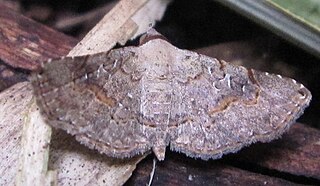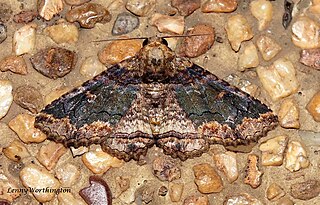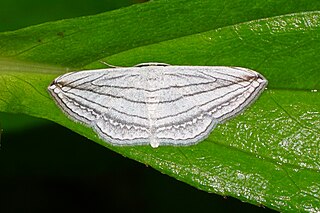
Atteva is a genus of moths in the monotypic family Attevidae. The group has a pantropical distribution; however, the range of at least one species, Atteva aurea, extends into the temperate zone. No consistent hypotheses regarding the relationships, placement, and ranking of Attevidae have been published, but the prevalent view is that they likely form a monophyletic group within the Yponomeutoidea.

Carposinoidea, the "fruitworm moths", is a superfamily of insects in the lepidopteran order. The superfamily is also known as Copromorphoidea, which is a junior synonym. These moths are small to medium-sized and are broad-winged bearing some resemblance to the superfamilies Tortricoidea and Immoidea. The antennae are often "pectinate" especially in males, and many species of these well camouflaged moths bear raised tufts of scales on the wings and a specialised fringe of scales at the base of the hindwing sometimes in females only; there are a number of other structural characteristics. The position of this superfamily is not certain, but it has been placed in the natural group of "Apoditrysia" "Obtectomera", rather than with the superfamilies Alucitoidea or Epermenioidea within which it has sometimes previously been placed, on the grounds that shared larval and pupal characteristics of these groups have probably evolved independently. It has been suggested that the division into two families should be abandoned.

Pterolonchidae is a small family of very small moths in the superfamily Gelechioidea. There are species native to every continent except Australia and Antarctica.

Nudaria is a genus of moths in the subfamily Arctiinae erected by Adrian Hardy Haworth in 1809.

Ugia is a genus of moths in the family Erebidae erected by Francis Walker in 1858.

Gyrtona is a genus of moths of the family Euteliidae first described by Francis Walker in 1863.
Luceria is a genus of moths of the family Erebidae. It was described by Francis Walker in 1859. This genus is found in southern Asia, Australia, on several Pacific islands and a few species also in Africa.

Rhesala is a genus of moths of the family Erebidae. The genus was erected by Francis Walker in 1858.

Trabala is a genus of moths in the family Lasiocampidae described by Francis Walker in 1856.

Exeliopsis is a genus of moths in the family Geometridae erected by Louis Beethoven Prout in 1938.

Sterrhinae is a large subfamily of geometer moths with some 3,000 described species, with more than half belonging to the taxonomically difficult, very diverse genera, Idaea and Scopula. This subfamily was described by Edward Meyrick in 1892. They are the most diverse in the tropics with the number of species decreasing with increasing latitude and elevation.

Pericyma cruegeri, the poinciana looper, is a moth of the family Erebidae. The species was first described by Arthur Gardiner Butler in 1886. It is found in south-east Asia including Hong Kong, Taiwan, Vietnam, Thailand, Sumatra, Peninsular Malaysia, Borneo, the Philippines, New Guinea, and in Australia, northern New South Wales and Queensland. Furthermore, it is an introduced species in Hawaii and Guam, where it was first detected in 1971. In Japan, it was first detected in 1986 in Ishigaki Island and the living area is expanded to Okinawa Island by 2000.
Meganola brunellus is a moth of the family Nolidae. It is found in Sri Lanka, India, Taiwan, Japan, the Ryukyu Islands, Sundaland, Queensland and the Bismarck Islands. It is an introduced species in Hawaii.

Eupitheciini is a tribe of geometer moths under subfamily Larentiinae, often referred to as pugs. The tribe was described by Tutt in 1896.

Scopula opicata is a moth of the family Geometridae first described by Johan Christian Fabricius in 1798. It is found in tropical Africa, including Malawi and Zambia, as well as in Sri Lanka, India, China (Hainan), Myanmar, Sundaland, the Philippines, Sulawesi, Timor and New Guinea.

Attonda adspersa is a moth of the family Erebidae first described by Rudolf Felder and Alois Friedrich Rogenhofer in 1874. It is known from the Democratic Republic of the Congo, Kenya, Madagascar, India, Sulawesi, Singapore, Borneo, Sumatra, Java, Bali, New Guinea and the Solomons.

Thumatha fuscescens is a moth of the family Erebidae first described by Francis Walker in 1866. It is found in Australia, South-East Asia, India, Sri Lanka, the Comoros, Réunion, Madagascar, and Gabon.

Terina is a genus of moths in the family Geometridae erected by Francis Walker in 1854.
Ctenane labuana is a moth of the family Nolidae. It was described by Charles Swinhoe in 1904. It is found on Borneo. The habitat consists of riverine forests, dipterocarp forests and alluvial forests.

Didiguides is a monotypic moth genus of the family Nolidae erected by Lutz W. R. Kobes in 1994. Its only species, Didiguides semifervens, was first described by Francis Walker in 1863. It is found on Borneo, Sumatra and Sulawesi, as well as in New Guinea and on the Bismarck Islands. The habitat consists of dipterocarp forests, including alluvial forests.
















